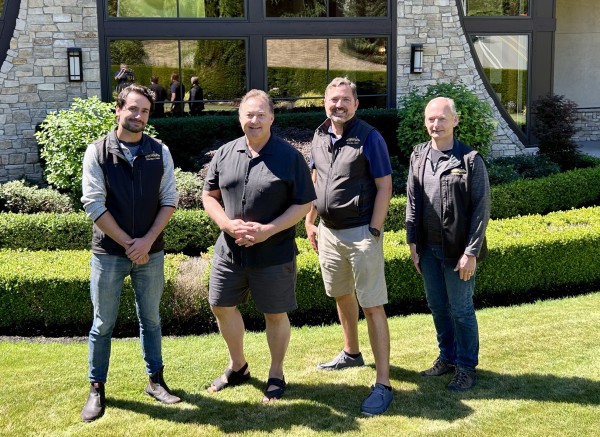
Quilceda Creek winemaking team. L to R: Richard Schumaker, Paul Golitzin, Mark Kaigas, Mike Doherty
It was big news in 2021 when Woodinville’s Matthews hired the Quilceda Creek winemaking triumvirate of Alex Stewart, Jesse Schmidt, and Hal Iverson. Quilceda Creek replacing that team has taken place more quietly but very effectively.
“We’ve got some incredible talent here that we brought in,” says Paul Golitzin, president and director of winemaking, who took over winemaking responsibilities from his father in 1992. “It’s exciting.”
New Quilceda Creek winemaker, Mark Kaigas
Quilceda Creek is as storied, if not more so, than any winery in Washington. The winery was founded in 1978 by Alex and Jeannette Golitzin as the 12th bonded, post-Prohibition winery in the state. Quilceda has a lengthy list of accolades and accomplishments in its relentless pursuit of Cabernet Sauvignon perfection.
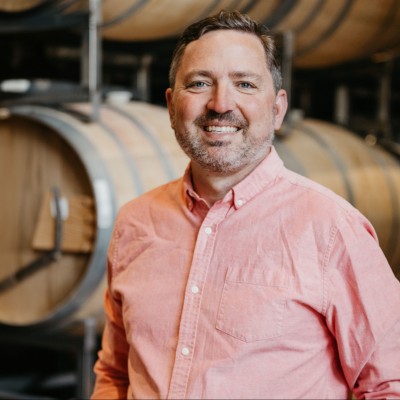
Quilceda Creek winemaker Mark Kaigas. Image courtesy Quilceda Creek.
Headlining the new winemaking talent is Mark Kaigas. A California native, Kaigas was working as a financial analyst when he got bit by the wine bug and enrolled in California State University, Fresno’s viticulture and enology program. Kaigas subsequently interned at Napa Valley’s Colgin Cellars – one of the highest flying cult wineries in the world, Castoro Cellars in Paso Robles, and Delegat in New Zealand.
In 2009, Kaigas was hired by Colgin as production assistant. He became assistant winemaker in 2011 and associate winemaker in 2018. Kaigas joined Quilceda Creek as winemaker in 2022.
“Mark is just an incredible talent,” Golitzin says. “He’s got a great scientific mind.”
During his time at Colgin, Kaigas worked on more than 30 wines that received scores of 95 points or above from various publications. This aligns well with Quilceda’s stratospheric track record over the decades.
“Between what I’ve accomplished here and the amount of highly-touted wines that he’s worked on, I don’t know if there’s any winery in the world that has ever had that many high scoring wines,” Golitzin says.
New assistant winemaker Richard Schumacher and cellar master Mike Doherty
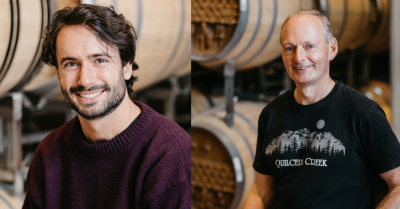
Quilceda Creek assistant winemaker Richard Schumacher (left) and cellar master Mike Doherty. Images courtesy Quilceda Creek.
Meanwhile, Richard Schumacher joined Quiceda in 2023 as assistant winemaker. A native of Washington, Schumacher earned a bachelor of science in bioengineering and biomedical engineering from Washington State University. He started his career in research and mathematical modeling, but interning as a cellar hand at Merry Cellars in college spurred an interest in wine.
Schumacher subsequently earned a master’s degree in viticulture and enology from University of California, Davis in 2019. He worked as a harvest intern at Kamen Estate in Sonoma, Dierberg (Santa Rita Hills), and Star Lane Vineyard (Santa Ynez). Schumacher subsequently worked as cellar master at Alma Rosa Winery in Solvang, California. He ultimately returned to Dierberg and Star Lane as a cellar technician and over time was promoted to assistant winemaker.
Finally, Mike Doherty came on board Quilceda Creek as cellar master in 2021 after starting as a harvest intern. Doherty brings a 30-year career at Boeing, experience as a home winemaker starting in 2010, and a tenure as president of the prestigious Boeing Employee Wine and Beer Makers Club that has launched a number of high-flying Washington wineries.
The changes in the winemaking team, still overseen by Golitzin, are not just a manner of personnel. They have also led to alterations in a number of winemaking practices. The winery has brought in new equipment. Processes have changed.
“We’re moving the wines differently, most of it by gravity or inert gas,” Golitzin says. “I was not doing that, and I do think that it’s better for the wine.”
Changes at Champoux Vineyard
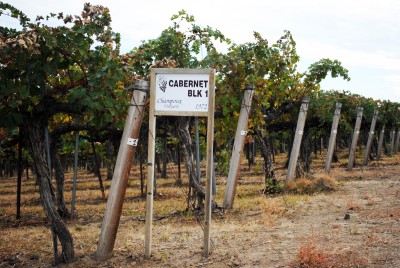
Champoux Vineyard, pictured 2009.
Quilceda has made other changes as well in recent years. The winery now farms an astonishing 200+ acres. The majority of that is at Champoux Vineyard in the Horse Heaven Hills, where Quilceda owns 134 of the vineyard’s 169 acres. (Read an article I wrote for Wine Enthusiast in 2022 about the appellation.)
First planted in 1972 as Mercer Ranch, Champoux is holy land for Cabernet Sauvignon in Washington. While the site is well-established, Quilceda has been replanting sections. Some of this started after a freeze in late 2010 killed some vines. Others are the natural processes of replacing vines as they age out.
“We replant two to five percent every year, depending on what you need to do and how fast,” Golitzin says of the winery’s vineyards. “It’s a big part of the business plan.”
Like many vineyards in Washington, Champoux was originally planted to Clone 8 Cabernet Sauvignon. That clone is being replanted in many parts of the vineyard, as it clearly excels there.
Champoux is also now planted to Clone 4, 8, 337, 191, and 685 Cabernet Sauvignon. Spacing at the vineyard has changed from 8×10 plantings to 3×7 – “a completely different animal” Golitzin says. Merlot and Cabernet Franc have also been planted.
Finally, a high degree of attention is being put into improving irrigation systems. This allows for watering the vineyard with a greater degree of specificity.
“A lot of our land is fairly flat, but I think it’s better because we’re trying to deliver water perfectly,” Golitzin says. “Our ability to control water gives us a big competitive advantage.”
Golitzin describes replanting parts of Champoux as a 10-year process, where approximately 60 acres will ultimately be renewed. In the end, it will allow this esteemed site to shine even brighter.
“The results are better, so we’re making that old site better, and the wines are getting better because we’re outgrowing what we used to have,” Golitzin says.
Mach One and Galitzine vineyards
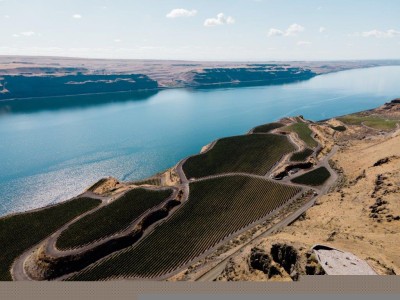
Mach One Vineyard, courtesy of Quilceda Creek
Quilceda has also invested heavily in Mach One Vineyard, also located in the Horse Heaven Hills. The 40-acre vineyard sits a mere 50-feet above the Columbia River.
The first plantings of Cabernet Sauvignon at Mach One were planted in 2009, with additional plantings in subsequent years. It’s a warm site, where bud break occurs early but where wind and the proximity to the Columbia River allow for extended hangtime.
“We basically get an extra month of growing season,” Golitzin says.
Mach One is also planted to a variety of clones. Two of these clones are now producing individual wines, including the Clone 685 Palengat Cabernet Sauvignon, named after the maiden name of founder Jeannette Golitzin. The other is the Clone 412 Tchelistcheff Cabernet Sauvignon, named after legendary winemaker André Tchelischeff, the maternal uncle of founder Alex Golitzin.
Paul Golitzin says the two clones show quite differently at Mach One. “With the 685, it has this inherent quality that has Cab Franc in it. It’s very beautiful, very perfumed, with some blue fruit quality and some black rock. [Clone] 412 has tons of black fruit and a lot of savory qualities. It’s kind of like the full meal deal. There’s everything from appetizer to dessert on that one.”
Finally, the winery has Galitzine Vineyard, a 17-acre site first planted in 2001 on Red Mountain. It’s planted at high density to Clone 8. Fruit from this vineyard goes into a Galitzine Vineyard Clone 8 designated wine. All of the vineyards are managed by Dan Nickolaus.
Clonal exploration and Cabernet exceptionalism
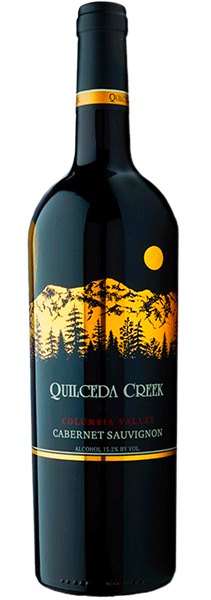 Quilceda Creek has been one of the wineries leading the way in Washington for clonal exploration of Cabernet Sauvignon. These different sites and clones do not just provide a broader palette to paint from each vintage. Given that some clones ripen earlier or later, they provide diversity in a changing climate. To wit, in a 10-year span, Washington saw its hottest and coolest vintages on record.
Quilceda Creek has been one of the wineries leading the way in Washington for clonal exploration of Cabernet Sauvignon. These different sites and clones do not just provide a broader palette to paint from each vintage. Given that some clones ripen earlier or later, they provide diversity in a changing climate. To wit, in a 10-year span, Washington saw its hottest and coolest vintages on record.
“It’s great insurance,” Golitzin says of the varied plantings.
It also makes for more complex wine. Quilceda’s flagship Cabernet Sauvignon, designated Columbia Valley, is 100% varietal in the 2020 vintage as in many recent years. However, it’s a blend of a number of different clones.
The 2020 vintage is comprised of clones 4, 8, 337, 191, and 685. 90% of the fruit comes from Champoux Vineyard, 10% from Mach One. It is, to my palate, the best wine I’ve formally reviewed from Quilceda Creek – no small accomplishment considering 2020 was the winery’s 42nd vintage and that Quilceda Creek consistently produces wines at the extreme upper end of the quality spectrum.
“I’m very happy with the recent vintages,” Golitzin says. “They’ve been exceptional.”
Ultimately, exceptionalism is what Quilceda Creek is all about. The focus is on continuous improvement, despite a track record that might temp some to rest on their laurels. In spite of the recent changes, Quilceda continues to do what it’s done for over four decades: make outrageously high quality wine.
“I think when anything negative happens, try to make a positive out of it,” Golitzin says.`
* * *
At Northwest Wine Report, all scores come from blind tastings in varietal/style sets. Read more about this site’s process for rating and reviewing wines. See Northwest Wine Report rating system and special designations. Read about how to interpret scores. See a list of recently reviewed producers.
Note that access to reviews and ratings at Northwest Wine Report now requires a subscription. Wineries submitting wines are under no obligation whatsoever to subscribe and can receive reviews freely after they have been published by contacting [email protected].
NOTE: Northwest Wine Report is now partially subscription-based. Please subscribe to support independent content and reviews on this site. It’s the only way that this site can continue.
To receive articles via email, click here.


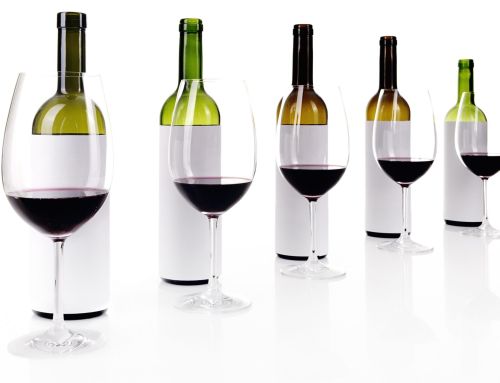

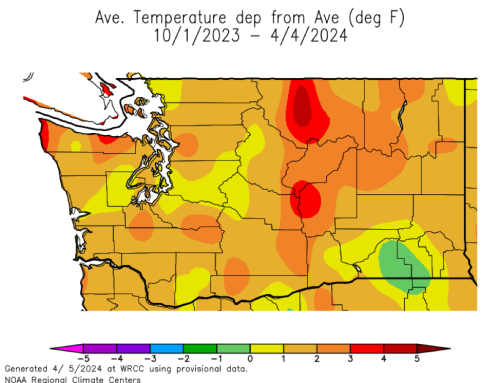
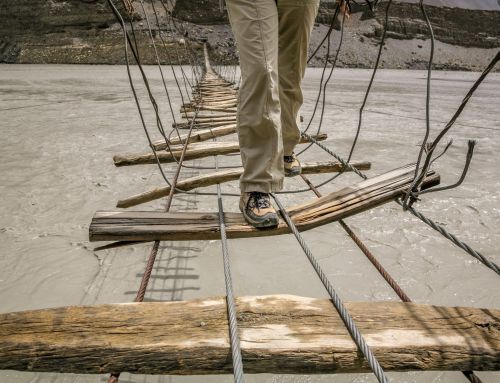

What a great article, Sean, I look forward to you writings!!